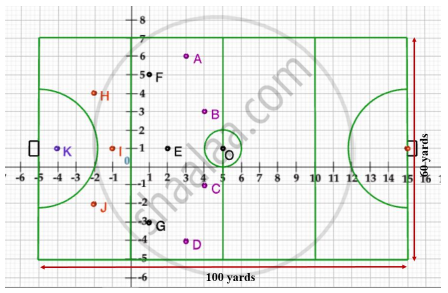Advertisements
Advertisements
Question
Prove that the points A (1, -3), B (-3, 0) and C (4, 1) are the vertices of an isosceles right-angled triangle. Find the area of the triangle.
Solution
AB =`sqrt((-3 -1)^2 + (0 +3)^2) = sqrt(16+9) = sqrt(25)` = 5
BC =`sqrt((4 + 3)^2 + (1 +0)^2)= sqrt(49+1)= sqrt(50) = 5sqrt(2)`
CA =`sqrt((1 -4)^2 + (-3 - 1)^2) = sqrt(9 + 16) = sqrt(25)` = 5
∵ AB = CA
A, B, C are the vertices of an isosceless triangle.
AB2 + CA2 = 25 + 25 = 50
BC2 = `(5sqrt(2))^2` = 50
∴ AB2 + CA2 = BC2
Hence, A, B, C are the vertices of a right-angled triangle.
Hence, ΔABC is an isosceles right-angled triangle.
Area of ΔABC = `(1)/(2) xx "AB" xx "CA"`
= `(1)/(2) xx 5 xx 5`
= 12.5 sq.units
APPEARS IN
RELATED QUESTIONS
If A(4, 3), B(-1, y) and C(3, 4) are the vertices of a right triangle ABC, right-angled at A, then find the value of y.
Show that the points (a, a), (–a, –a) and (– √3 a, √3 a) are the vertices of an equilateral triangle. Also find its area.
The value of 'a' for which of the following points A(a, 3), B (2, 1) and C(5, a) a collinear. Hence find the equation of the line.
Show that the points A (1, −2), B (3, 6), C (5, 10) and D (3, 2) are the vertices of a parallelogram.
Find the distance between the points
A(1,-3) and B(4,-6)
Find the distance between the following pairs of point.
W `((- 7)/2 , 4)`, X (11, 4)
Find the distances between the following point.
P(–6, –3), Q(–1, 9)
Find the distance of a point (13 , -9) from another point on the line y = 0 whose abscissa is 1.
Find the point on the x-axis equidistant from the points (5,4) and (-2,3).
The centre of a circle passing through P(8, 5) is (x+l , x-4). Find the coordinates of the centre if the diameter of the circle is 20 units.
In what ratio does the point P(−4, y) divides the line segment joining the points A(−6, 10) and B(3, −8)? Hence find the value of y.
Find the distance between the origin and the point:
(-5, -12)
A point P lies on the x-axis and another point Q lies on the y-axis.
Write the abscissa of point Q.
Calculate the distance between the points P (2, 2) and Q (5, 4) correct to three significant figures.
If the length of the segment joining point L(x, 7) and point M(1, 15) is 10 cm, then the value of x is ______
The point which divides the lines segment joining the points (7, -6) and (3, 4) in ratio 1 : 2 internally lies in the ______.
Case Study -2
A hockey field is the playing surface for the game of hockey. Historically, the game was played on natural turf (grass) but nowadays it is predominantly played on an artificial turf.
It is rectangular in shape - 100 yards by 60 yards. Goals consist of two upright posts placed equidistant from the centre of the backline, joined at the top by a horizontal crossbar. The inner edges of the posts must be 3.66 metres (4 yards) apart, and the lower edge of the crossbar must be 2.14 metres (7 feet) above the ground.
Each team plays with 11 players on the field during the game including the goalie. Positions you might play include -
- Forward: As shown by players A, B, C and D.
- Midfielders: As shown by players E, F and G.
- Fullbacks: As shown by players H, I and J.
- Goalie: As shown by player K.
Using the picture of a hockey field below, answer the questions that follow:

The point on y axis equidistant from B and C is ______.
Point P(0, 2) is the point of intersection of y-axis and perpendicular bisector of line segment joining the points A(–1, 1) and B(3, 3).
If (a, b) is the mid-point of the line segment joining the points A(10, –6) and B(k, 4) and a – 2b = 18, find the value of k and the distance AB.
Find distance between points P(– 5, – 7) and Q(0, 3).
By distance formula,
PQ = `sqrt(square + (y_2 - y_1)^2`
= `sqrt(square + square)`
= `sqrt(square + square)`
= `sqrt(square + square)`
= `sqrt(125)`
= `5sqrt(5)`
